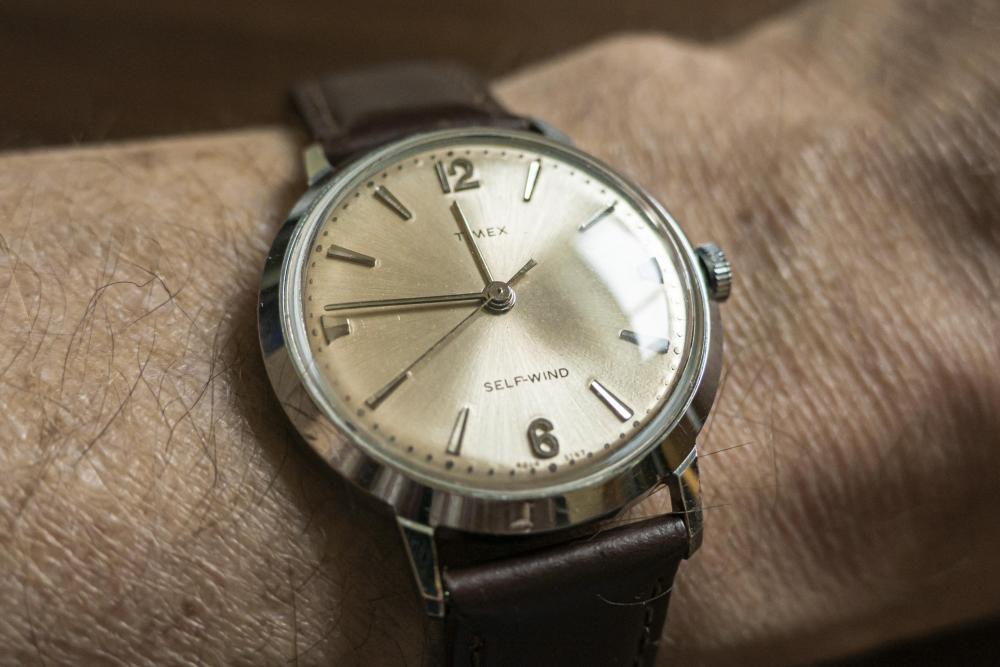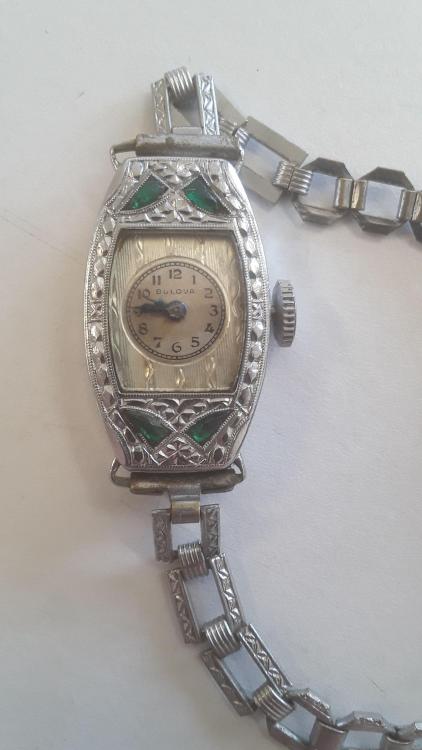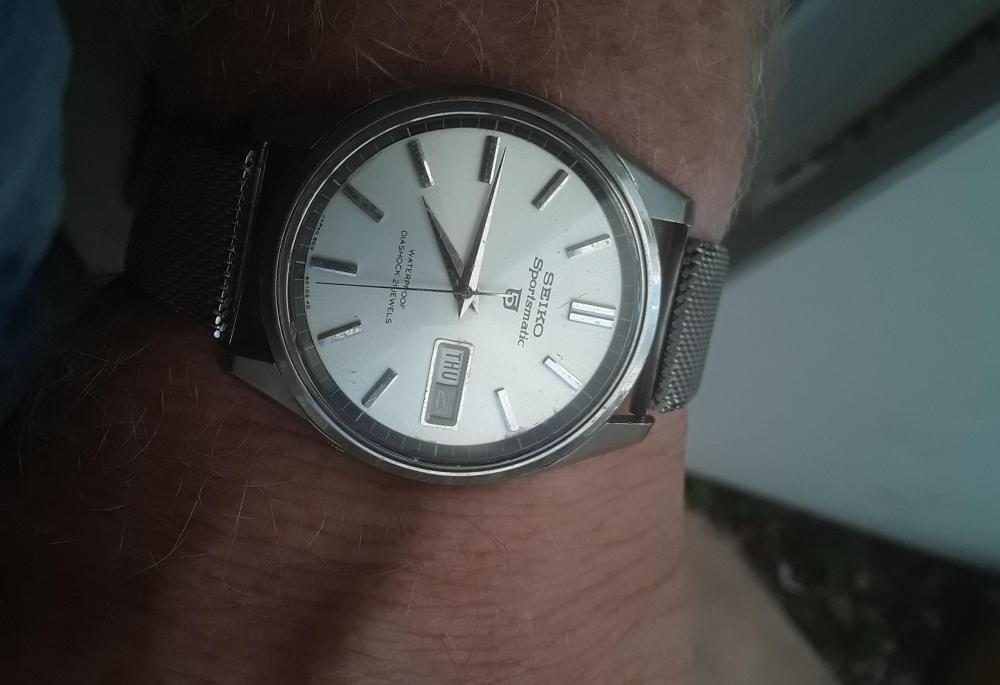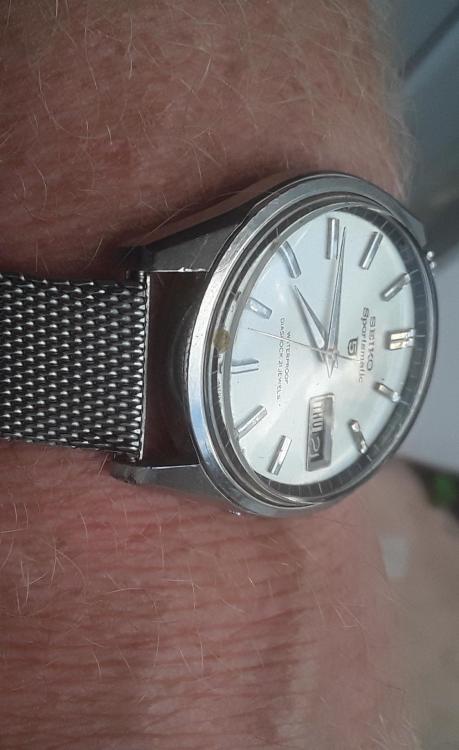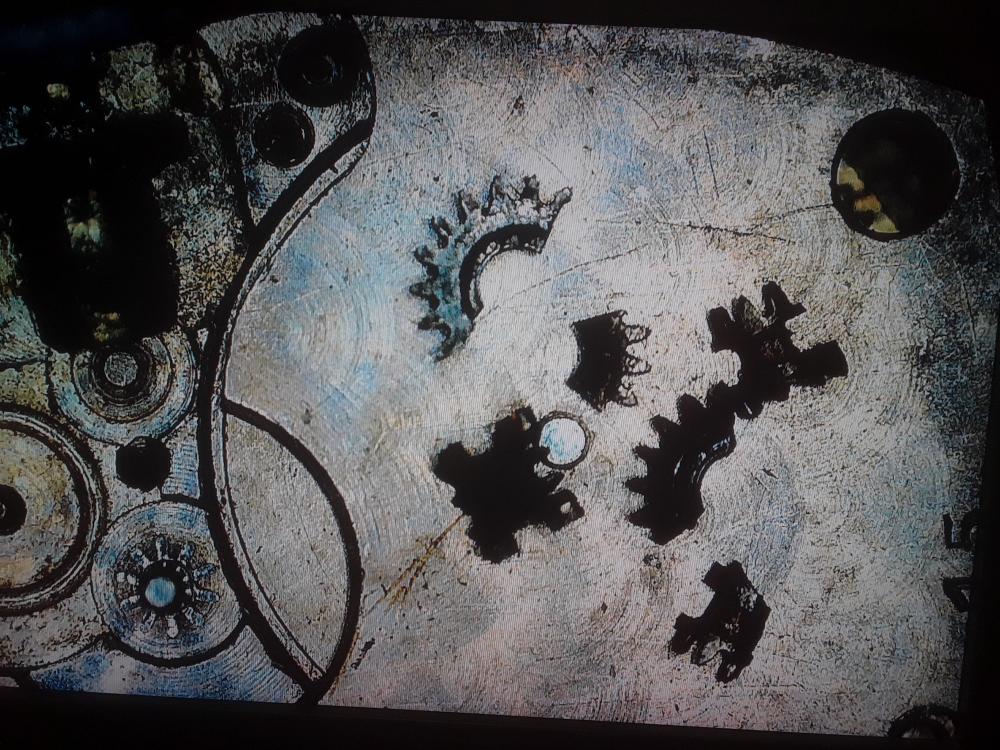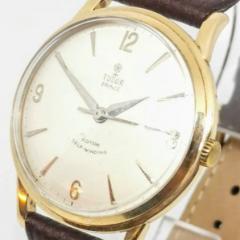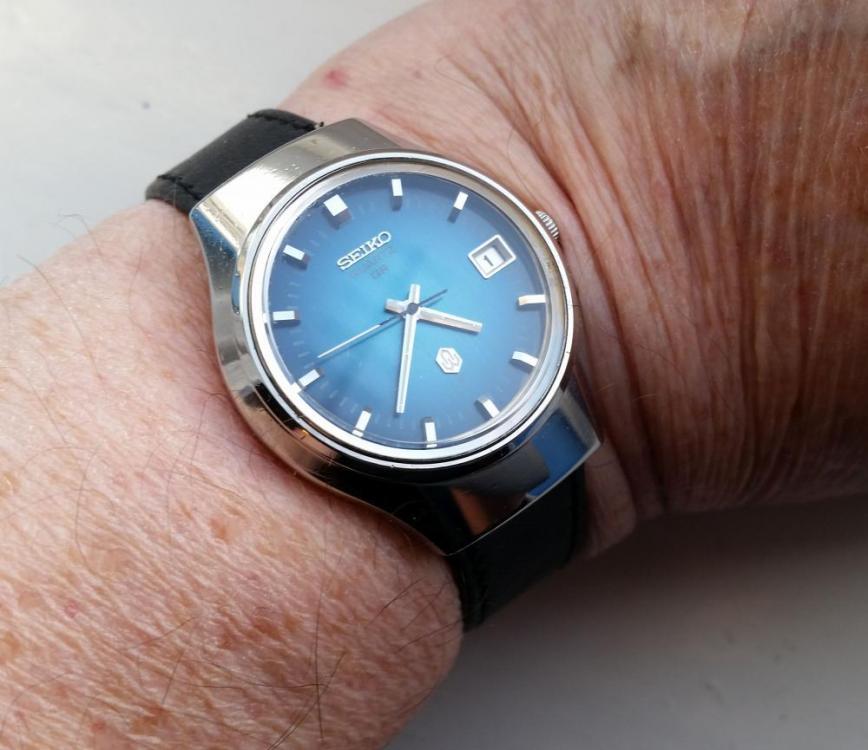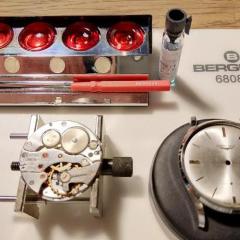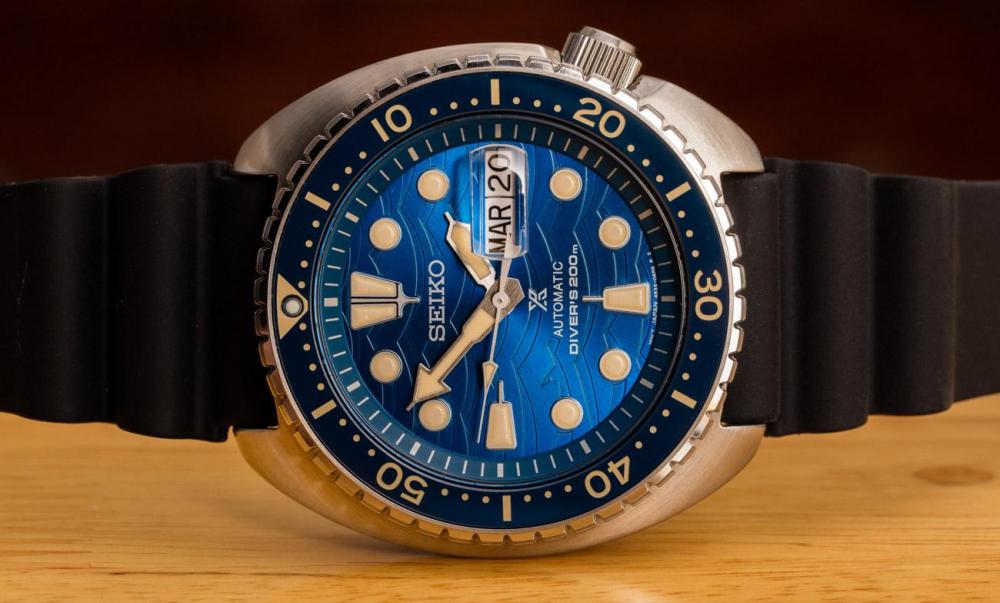Leaderboard
Popular Content
Showing content with the highest reputation on 05/22/20 in all areas
-
In the process of trying/learning to get my Dad's old Timex up and running (again), I've gone through several movements to perfect the art of hairspring destruction. Using the face from my Dad's watch and the best hands/case of the lot, I was able to get a very clean working version. I chose my Dad's face because it has a warmer, champagne-like tint to it, while the others were more silver. The champagne contrasts nicely with the plated case and hands. The crystal also polished up very nicely. Hoping to cherry-up the others with working guts in the future. - j2 points
-
Looks good. I did the same with my father's Seiko and Timex. Sure wish he was here.2 points
-
I'm a sucker for older Seikos and stumbled upon this today. It's very clean inside and out, didn't have a band on it but had this one laying around. I think the black chapter ring gives it an extra kick. Also got this Bulova from the same seller. It's currently not running so I now have a project for tomorrow. I haven't had a score in a while, but for $20 for the pair I'm satisfied for a while.2 points
-
And i think it's the last one from this line(if anyone seen any other please let me know)2 points
-
I salute your gallant attempt. I think your best bet is to take the motor to a motor repair or appliance repair shop to get it fixed. The two carbon brushes should have be removed first before taking the motor cover off. The 2 black bakelite knobs on the sides have screwed on covers. Unscrewing it will release the spring which pushes the carbon brushes against the motor commutator. It should be a simple fix for someone with the right knowledge.2 points
-
Your motor ain't gonna run without those 2 graphite-looking pieces. Those are brushes and are what electrifies the coils and turn it into electromagnet to make it spin.2 points
-
In all my years being a watch/clock maker I have never seen a French clock movement that has a years duration. I never thought such a movement existed until now. This is as rear as rocking horse s***. What a wonderful piece of craftsman ship. Working on five barrels a great piece of art. https://www.ebay.co.uk/itm/Year-Going-Five-Barrelled-French-Clock/114232052146?hash=item1a98c2c9b2:g:aDoAAOSwjYFex5bP1 point
-
1 point
-
Very nice. I have an original Seiko Diver from 1980 with the turtle case Sent from my iPhone using Tapatalk Pro1 point
-
There is a US company called Sherline. They sell quality lathes and have 8mm lathe 3 jaw chucks with an adapter. I did a review on YouTube. Sent from my iPhone using Tapatalk Pro1 point
-
I have limited knowledge on the subject but I have rebuilt a cleaning machine which turned out working okay without having to replace anything besides the wiring but I can't be sure I did any of it right so take my 2 cents for what they're worth. There should be four cables that connect to the motor. Here is what I did, I connected the 2 that came from the potentiometer to the brushes because that will control the voltage supplied to the rotor and allow me to control the spin rate through the knob. The other 2 cables would have fixed voltage which I connected to the stator (the unit of stack of iron plates surrounding the rotor). Here's where I hope more knowledgeable people can chime in. Everything works but not flawlessly. When I set it to a certain speed, I can see/hear the motor occasionally speeding up/slowing down on it's accord without the knob being touched. Should it be doing that? What could be the problem? Was my cabling wrong? What would happen if I connected the potentiometer cables to the stator instead?1 point
-
1 point
-
The plates are soft iron, and you can probably push them back together with your thumbs (or with a few gentle taps with a nylon hammer or similar). Good luck finding the correct bearings. You may be in luck, but unless they are particularly bad, then other than a good clean and a little machine oil in them, I think I might leave well alone. The brushes are probably much easier to find. If you can't get an exact match you could cut larger ones to size. Graphite can be cut with a junior hacksaw, and filed and sanded to shape but it is brittle and easy to fracture if you are a little heavy handed, so don't try jamming it in the vice without some sort of soft jaws, or you will just end up with a pile of broken pencil lead. Getting the curve of the brush where it runs against the commutator right can be done by clamping the lump of graphite between a couple of bits of wood, and running a wood drill next to the edge in the drill press to get a rough profile. Use a drill bit the same diameter as the commutator. You can also do this by gluing some sand paper to a dowel of the correct diameter and putting that in the drill press. This slower but less likely to grab the brush and break it. Running the brush in the motor will bed in the correct profile, once you have it almost correct. Heat shrink tubing would probably be a good idea on those parts where the old sheathing is looking dodgy.1 point
-
What does it think it is? A Sekonda? I've seen a couple of USSR era Secondas with almost identical issues, but not a Bulova. I suspect that things got a little tarry in the keyless works, and someone decided brute force was the answer. Presumably you have enough bits to make one good mechanism.1 point
-
WHOA! No oil on the commutator! Oil would mix with the carbon dust as the brushes wear down and form a sludge which would short out the commutator eventually.1 point
-
1 point
-
That is just a less refined "petroleum ether" above. Leave a drop evaporate on a clean glass, if it leaves no residue then it will be fine.1 point
-
I feel that this is to hold your phone by way of suction lol and you repurposed it too............remove casebacks? Lol Sent from my iPhone using Tapatalk Pro1 point
-
Brushes wear out anyway and are renewable and should be available at material houses, commutator contact surface if rough can be turned on a lathe, you should also check the shaft and bearings/bushings for wear and turn if neccessary and grease ( heat resistant grease) The coil also is to be checked electrically. I would check above mentioned parts for wear, if alright just clean grease and instal new brushes, if worn and you have no access to a lathe, you got to let someone who dose ,fix it.1 point
-
1 point
-
1 point
-
Try looking for a company that does alternator rewinds or a competent Auto. Electrician in your local area. They might be able to help you with advice or sugest an alternative small electric motor that could be used without breaking the bank. I've had a few alternators and starter motors for old motorcycles refurbished with brushes replaced locally over the years for a reasonable cost. Sent from my moto g(6) play using Tapatalk1 point
-
1 point
-
Thank you. Yes those Bulova movements are a pain. On the upside though I have two parts moments for this one. The stem doesn't pull in or out, it rotates but does nothing. So I have a starting place for it. The balance is good though so that's a plus.1 point
-
That one is a bit of a rare beast, a November 1973 JDM 3862-7010, my second earliest Seiko analogue quartz watch, (and it is a 'QR' not a 'QZ'), the earliest being this August 1972 3862-7040, which is not a JDM watch but a very early export one, having an English/German day wheel.. that's new price at the time of 130,000Yen was 30,000Yen more than the new price of my Grand Quartz in 1977....1 point
-
1 point
-
Nice JDM watch there, I suppose you realise that it will have an English/Kanji day wheel?. I don't have a blue faced 0923 QZ, only this silver faced GP 0923-8000..... And this 0922-8060 (date only) in stainless Out of about 40 examples of these early analogue quartz watches I don't have one with an '-8040' case... Nearest I have to that is a couple of 0903-8049's This 4633-8049..... This 0903-8089... And this 0903-8099...... Plenty of other blue faced 4004's (export version) though, mainly with 0903 movements though a couple with 4633 movements...1 point
-
I'm only 17 so money is limited. This trick saved me a lot of problems. Changing the balance staff would be a pretty convenient skill though.. Thanks for all the help!! Keeps excellent time now1 point
-
unfortunately my experience with the snake oil was different.. In the early days I had a Seiko watch that no oil didn't work 9010 at least I assume was using 9010 didn't work . But what we may be seeing is the difference between the viscosity of the two oils and this was a really tiny Seiko quartz watch which 9000 solved my problem. then minor problem with using the BHI practical exam as an example. The problem with any of the exam watches are impatient students that want the results quickly.. The only good test of lubrication is time and having students wait five years to see if their watches still running perfectly just isn't going to work. out of curiosity looking at the ETA technical documents first watch I see is 4 7/8´´´ ETA E01.001 which works out perfectly nice small line watch. looks like you're correct that ETA must think 9000 snake oil as they do not recommend it.. On the other hand they're not recommending 9010 either? Their recommendation is Moebius 9014? http://www.moebius-lubricants.ch/en/products/specialities1 point
-
The only downside with tips and trix like this is the solution will make a shockproof solution to a less shockproof one. The design of the most the springs are designed to hold a doomed jewel and all of a sudden you dont have one, instead it rests on the edges of the spring which makes it more rigid and stiff, a shock will probably not just break the pivot bet also damage the jewel. Personaly I wouldn't do things like this or even recommend it. (The grumpy HSL speaking )1 point
-
Thanks for this I was thinking along same lines, however looks like the guy on the link above has one1 point
-
@AndyHull I will try and get some pics of mine tomorrow1 point
-
1 point
-
1 point
-
Hamilton 992 with a salesman case. Sent from my iPhone using Tapatalk Pro1 point
-
I suppose if you leave a bubble there and a cross hair in the middle of the dial you could use it as a sprit level for your balance wheel poising1 point

